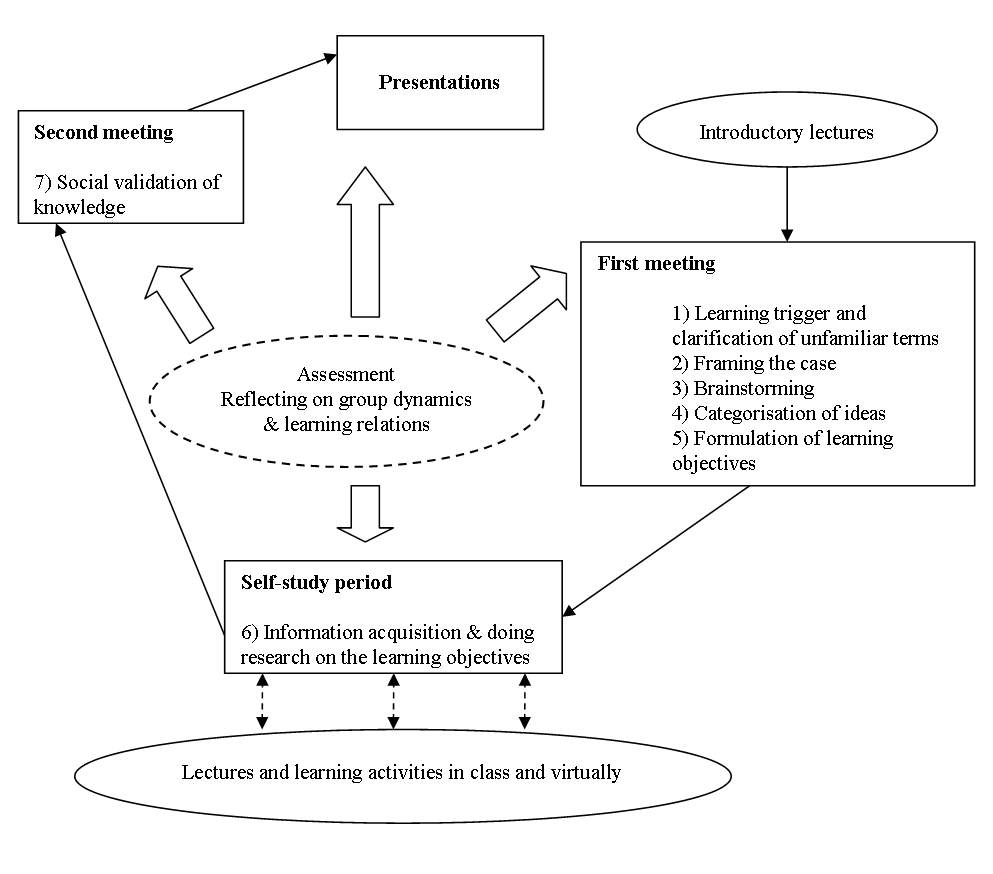Problem-Based learning and critical reflexivity in CSR education (10.5.2023)
Experiential learning pedagogies have proved to be valuable tools for supporting CSR learning. I share here my personal experiences with one of these pedagogies, problem-based learning (PBL). I used this experiential learning approach in two Masters-level courses. My initial motivation for using PBL was to promote student’s ability to define business and society issues and simulate responsible business decision making that considers economic, social and environmental objectives. After my first experiences with PBL, I realised that PBL did not only offer students the possibility to learn how to make responsible business decisions, but it also created a space for thinking more critically about the role of business in society. In this post, I briefly introduce PBL and how it can support critical reflexivity in CSR education. I also offer some insights on how to implement PBL practice.
What is PBL?
PBL was introduced in the 1960s at McMaster University for the purpose of medical education. Several educational fields have since adopted PBL, including education, engineering, and management. The use of a problem as a starting point for learning represents the main characteristic of PBL. The term “problem” refers to a situation involving an option for development or improvement. In management education, PBL has been seen as an educational method to support students in developing knowledge and personal competencies for managing organisations in today’s global business environment. This view is in line with the idea of management education as a matter of economic efficiency at the service of business organisations.

This way of thinking has been challenged by business educators who believe that PBL can play a key role in promoting responsibility in marketplaces and society at large. Indeed, some educators has suggested PBL as an opportunity to create spaces where students are encouraged to question the underlying assumptions of business practice and to think more critically about how these assumptions affect other people’s lives (Lindén and Alanko-Turunen, 2006). I find this view to be particularly relevant for incorporating reflexive practice in CSR learning.
How to use PBL in the CSR classroom?
I have used PBL in courses of 15-20 students where lectures were part of the learning activities. This form of PBL is known as hybrid-PBL (see figure below). After two introductory lectures, the class is divided in groups of five to six students and each group is invited to attend the first meeting under the facilitation of the instructor. It is in this meeting that the PBL process (steps 1-6) starts with the vignette (learning trigger) illustrating a business situation in which values are in conflict. During the first meeting, the students frame the case, identifying key issues related to the vignette, and set the learning objectives to acquire the knowledge that is necessary to deal with the situation.

Hybrid problem-based learning process. Source: García-Rosell (2013), adapted from Alanko-Turunen (2005).
After the meeting the students engage in a three-week self-study period guided by the learning objectives set in the first meeting. The self-study period is supported by lectures and other learning activities. From the point of view of CSR learning, improving the situation is not the main objective; the most important thing is to trigger moral deliberation and critically reflexive thinking on business practices and their impact on society and nature. After the self-study period, each group is invited to attend a second meeting to discuss the results of their inquiry. After the second meeting, the students have two weeks for presenting their results and reflections to the rest of the class.
PBL requires a high degree of commitment from the instructor, who takes the primary responsibility for leading students beyond the problem-solving spectrum towards more critical reflexive practices. Indeed, the strong weight of PBL on problem solving can lead students to frame business and society issues as simple managerial problems and thus perceive CSR as a strategic tool for solving them. On the other hand, the instructor should be ready to engage with emotional dynamics. In particular, PBL may result in considerable discomfort and distress for students who are used to traditional ways of learning and are new to the field of business and society.
References:
Alanko-Turunen, M.(2005) Negotiating Interdiscursivity in a Problem-Based Learning Tutorial Site: A Case Study of an International Business Programme. Tampere: University of Tampere.
García-Rosell, José-Carlos (2013). Struggles over CSR meanings in teaching practices: The case of problem-based learning. Management Learning, 44(5), 537-555.
Lindén, J. and Alanko-Turunen, M. (2006) Deconstructing Conceptions of Problem-Based Learning. In: Poikela, E. and Nummenmaa, R. (eds) Understanding Problem-Based Learning, pp. 51–64. Tampere: University of Tampere.
Text: José-Carlos García-Rosell
Associate Professor of Corporate Social Responsibility in Tourism
Yliopistonlehtori, Dosentti
Master’s Programme Director, Tourism, Culture and International Management
The blog article was originally published in (1.11.2020): https://www.jcgarciarosell.com/post/problem-based-learning-pbl-and-critical-reflexivity-in-csr-education